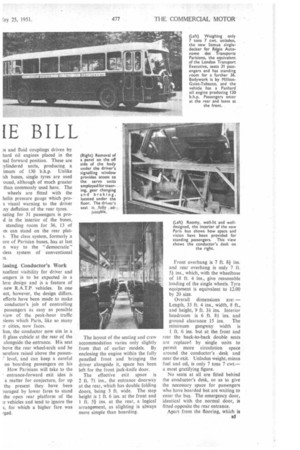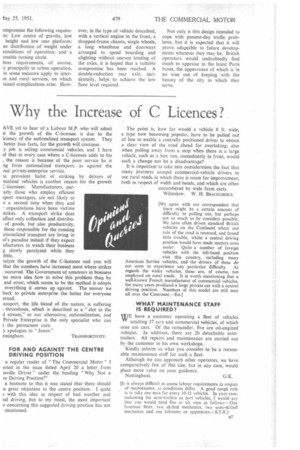ORTHODOXY FILLS IE BILL
Page 38

Page 39

Page 40

Page 41

If you've noticed an error in this article please click here to report it so we can fix it.
By Alfred Woolf, B.A.
New Buses for the Paris Transport Board Represent the French Solution of Urban Traffic Problems, Combining Conventional Mechanical Details and Modern Passenger-handling Methods
EEP1NG pace with the changing needs of the population of a capital city is only one of the operational problems which face the transport boards of cities like London and Paris. An active and healthy vehicle-building industry in this country was of immeasurable value in assisting the London Passenger Transport Board (as it then was) to fall into step with postwar conditions.
Stripped of men, machinery and materials by the defeated Germans, the French vehicle industry has faced, since 1945, an almost impossible task of reconstruction. Only now are some of the results of these efforts being seen. The reconstitution of Parisian surface transport after the war is an epic of modern times. The story of how, after the hasty departure of the German forces, the Paris bus undertaking began almost from the very beginning with next to no equipment, is well known.
From the roads and ditches of northern France, Belgium and Germany, the buses were brought back to their depots, reconditioned, rebodied and pressed into service with the utmost haste. Only three years later was it possible to turn from the urgent task of the moment to thoughts of the future. Now. after a further lapse of time, new vehicles are being seen in the service of the Rdgie Autonome des Transports Parisiens.
The decision to build ehicles clearly Intended for many long years of service, rather than to make use of whatever could be obtained, must be accounted a courageous one. It is also typically French, and I felt, as I examined the latest buses for • Paris, that such sturdy structures were redolent-of the character of the nation as a whole.
At the moment an order for 200 new buses is being completed by Million-Guiet-Tubauto, S.A., Argenteuil, and I was informed that eventually some 3,000 new machines would probably be built to replace and expand the existing fleet. Two routes in the centre of Paris are already served by the newest additions.
3s and fluid couplings driven by hard oil engines placed in the nal forward position. These are ;ylindered units, producing a imum of 130 b.h.p. Unlike ish buses, single tyres are used .ound, although of much greater than commonly used here. The
wheels are fitted with the helin pressure gauge which pros visual warning to the driver .ny deflation of the rear tyres. .ating for 31 passengers is prod in the interior of the buses,
standing room for 36, 13 of rn can stand on the rear plat i. class system, formerly a ure of Parisian buses, has at last n way to the "democratic" ;less system of conventional is.asing Conductor's Work xcellent visibility for driver and ;engers is to be expected in a lern design and is a feature of new R.A.T.P. vehicles. In one ect, however, the design differs, efforts have been made to make conductor's job of controlling passengers as easy as possible view of the peak-hour traffic )1ems which Paris, like so many !tcities, now faces.
hus, the conductor now sits in .a 11 glass cubicle at the rear of the alongside the entrance. His seat bove the rear wheel-arch and he ierefore raised above the passen' level, and can keep a careful on boarding passengers on his
How Parisians will take to the • entrance-forward exit idea is a matter for conjecture, for up the present they have been Yuraged by lower fares to stand the open rear platform of the :r vehicles and tend to ignore the s, for which a higher fare was rged. The layout of-the seating and crew accommodation varies only slightly from that of earlier models. By enclosing the engine within the fully panelled front and bringing the driver alongside it, space has been left for the front jack-knife door.
The effective exit space is 2 ft. 7/ ins., the entrance doorway at the rear, which has double folding doors, being 3 ft. wide. The step height is 1 ft. 6 ins, at the front and 1 ft. 51 ins, at the rear, a logical arrangement, as alighting is always more simple than boarding. Front overhang is 7 ft. 84 ins. and rear overhang is only 7 ft. 54 ins., which, with the wheelbase of 18 ft. 4 ins., give reasonable loading of the single wheels. Tyre equipment is equivalent to 12.00 by 20 size.
Overall dimensions are: — Length, 33 ft. 4 ins., width, 8 ft., and height, 9 ft. 3/ ins. Interior headroom is 6 ft. 8/ ins, and ground clearance 15 ins. The minimum gangway width is 1 ft. 6 ins, but at the front and rear the back-to-back double seats are replaceri by single units to permit more circulation space around the conductor's desk and near the exit. Unladen weight, minus fuel and oil, is only 7 tons 7 cwt.— a most gratifying figure.
No seats at all are fitted behind the conductor's desk, so as to give the necessary space for passengers who have boarded but are waiting to enter the bus. The emergency door, identical with the normal door, is fitted opposite the rear entrance.
Apart from the flooring, which is B5 of tongued and grooved hardwood, the bodywork is all metal. Body framing is of the type developed by Million-Guiet for its chassisless buses and employs mainly squaresection steel tubing, electrically welded to form a stress-bearing structure. No rivets or bolts are used in the framing. Pillars and rails are braced by suitably arranged diagonals and the roof is a separate jig-built unit, assembled complete with cant-rails. All the units are jigbuilt, and complete interchangeability is thus ensured.
No part of the panelling performs a stress-resisting function, although it is interesting to note that the R.A.T.P. engineers insist that the roof shall be capable of supporting the weight of a man at any point! A light alloy of a heavier gauge than is commonly used in Britain forms the exterior panelling. It is attached. to the framing by bolts for which patented caged nuts are provided in the pillars and rails.
Panels Easily Removable
In the event of damage, any panel can be removed with the aid of a screwdriver and if a pillar or rail be damaged, this is cut out and a replacement welded into place. Experience has shown that with this system of construction, damage sustained in accidents is highly localized.
No bitumastic compounds are used in painting the vehicles. Instead, body-framing members are faced with a strip of felt on which the panelling rests. Drumming, as well as exterior noise, is reduced to a low level, the former, in fact, being almost entirely eliminated. Partly responsible for the absence of drumming is the use of ribbed interior panels, the pressed longitudinal ribs giving a high degree of resistance to resonance and distortion The roof is, of course, doubleskinned and filled with sound-proofing material. Special attention is B6 paid in the design of the framing to provide for adequate drainage of the inter-panel space, a vital factor in all-steel bodywork, although the framing and panelling are chemically treated by dipping to resist corrosion.
Six of the side windows, which are over 4 ft. wide, are of full-drop type controlled by Klein balancing gear. Two half-drop balanced windows are fitted in the rear panelling. Openweave blinds which roll up into concealed compartments are located above the side windows.
British bus operators would be interested in the heating and ventilating system employed. Fresh air for the Schneebelli heaters is drawn in through grilles beneath the windscreen. A thermostat controls the interior temperature and the equipment can convert an ambient temperature of 14 degrees F. (18 degrees of frost) into an internal temperature of 50 degrees F. Additional fresh air is distributed throughout the interior from intakes above the windscreen, which is recessed beneath the forepeak of the roof.
Further indications of the thoroughness with which the designers have considered the suitability of the vehicle for its admittedly strenuous duties are provided by the maintenance arrangements. At the front and rear, the lower corners of the panelling are independent of the main body structure and may be readily removed. Rubber piping provides a clean, invisible joint. At the front this facilitates chassis overhaul. On the other hand, the appearance is improved by the full panelling.
On the driver's side, a large side panel may be unlocked to give access to the steering, brake and gearbox servo mechanism. The near-side front panel covers all the fuse boxes and main junction boxes of the elec
trical gear. Grouped thus at the front, the electrical equipment can be examined with ease almost daily and readily serviced.
The rear corner panels, too, can be quickly removed, a useful point, for these areas lead a notoriously hard life in heavy traffic, and battered rear quarters do not look particularly attractive. These details, the counterparts of which will be found in all the rolling stock of London Transport Executive and in the vehicles employed by any opera tor of sufficient size to enable a large production order to be built, distinguish the designs of such organizations. Unhappily, the smaller operator cannot call the tune, for the manufacturer, in his case in the role of piper, holds the controlling hand.
In France, however, the lead given by R.A.T.P. is being followed by numerous municipal undertakings, and I have seen both motorbuses and trolleybuses closely resembling the Paris bus, under construction for towns as widely separated as Strasbourg and Lyons. In the new vehicles, an attempt has been made ompromise the following requirets: Low centre of gravity, low height and low rear platform; )er distribution of weight under conditions of operation; and a onable turning circle, hese requirements, of course, ly principally to urban operation, in some measure apply to interin and rural services, on which tional complications arise. How ever, in the type of vehicle described, with a vertical engine in the front, a dropped-frame chassis, single wheels, a long wheelbase and doorways arranged to speed boarding and alighting without uneven loading of the axles, it is hoped that a suitable compromise has been reached. A double-reduction rear axle, incidentally, helps to achieve the low floor level required. Not only is this design intended to cope with present-day traffic problems, but it is expected that it will prove adaptable to future developments whatever they may be. British operators would undoubtedly find much to appraise in the latest Paris buses, the appearance of which is in no wise out of keeping with the beauty of the city in which they serve.
Based on Somua chassis, the new buses have Wilson preselective gear




















































































